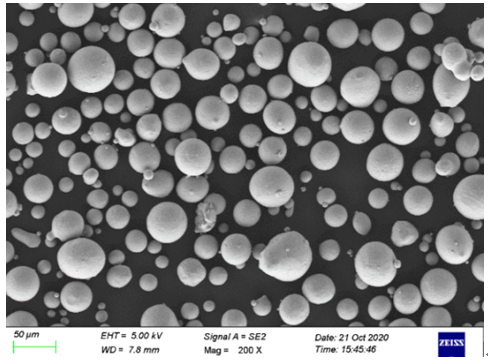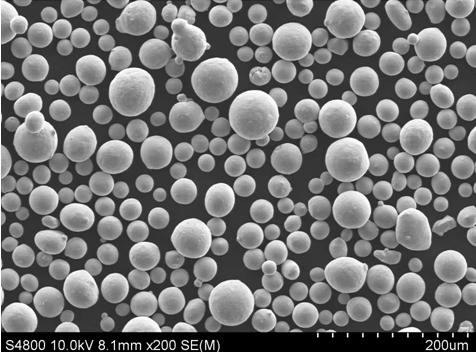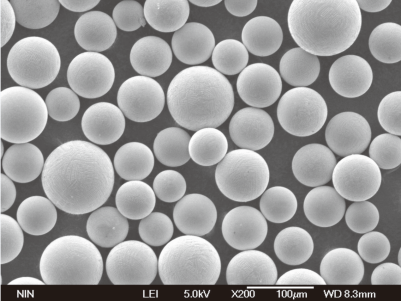소개
고순도 철 분말 은 야금에서 전자 제품에 이르기까지 다양한 산업 분야에서 사용되는 중요한 재료입니다. 하지만 정확히 무엇이 그렇게 특별하게 만드는가? 일반 철 분말과 어떻게 다를까요? 이 가이드에서는 고순도 철 분말의 세계를 깊이 파고들어 조성, 특성, 응용 분야 등을 살펴봅니다. 노련한 전문가이든 호기심 많은 학습자이든, 이 기사는 고순도 철 분말에 대한 모든 질문에 답하도록 설계되었습니다.
고순도 철 분말 개요
고순도 철 분말은 순도가 99.9% 이상인 철 분말입니다. 고유한 특성으로 인해 고강도, 우수한 전도성 또는 특정 자기 특성이 필요한 특수 응용 분야에 이상적입니다. 고순도 철 분말의 생산에는 분무 또는 환원과 같은 고급 공정이 포함되어 일관된 입자 크기와 모양을 가진 미세 분말이 생성됩니다.
고순도 철 분말의 주요 특성
- 순도: 일반적으로 99.9% 이상
- 입자 크기: 몇 마이크로미터에서 수백 마이크로미터까지 가능
- 모양: 생산 방법에 따라 구형 또는 불규칙
- 자기 속성: 높은 포화 자화
- 전기 전도성: 고순도 수준으로 인해 우수

고순도 철 분말의 조성 및 특성
| 속성 | 설명 |
|---|---|
| 순도 | 99.9% 이상 |
| 입자 크기 | 몇 마이크로미터에서 수백 마이크로미터까지 |
| 모양 | 구형 또는 불규칙 |
| 자화 포화 | 높음 |
| 전기 전도성 | 불순물이 최소화되어 우수 |
| 밀도 | 입자 크기와 모양에 따라 다름 |
| 표면적 | 미세 분말에서 더 높음 |
| 산소 함량 | 낮음, 최소 산화 보장 |
유형 및 모델 고순도 철분 분말
특정 응용 분야에 맞게 조정된 다양한 유형의 고순도 철 분말이 있습니다. 이러한 유형 간의 차이점은 입자 크기, 모양 및 생산 방법에 있습니다. 아래에서는 시장에서 사용할 수 있는 가장 일반적인 모델 중 일부를 논의합니다.
1. 분무 철 분말
분무 철 분말은 용융 철을 미세한 방울로 분산시켜 분말로 응고시키는 분무 공정을 통해 생산됩니다. 이 유형은 일반적으로 구형이며 유동성 및 충전 밀도가 중요한 응용 분야에 사용됩니다.
- 순도: 99.9% 이상
- 애플리케이션: 분말 야금, 자기 재료, 금속 사출 성형(MIM)
2. 환원 철 분말
환원 철 분말은 수소 분위기에서 철광석 또는 밀 스케일을 환원하여 생산됩니다. 일반적으로 불규칙한 모양이며 화학 반응 또는 촉매와 같이 표면적이 중요한 응용 분야에 사용됩니다.
- 순도: 99.5% ~ 99.9%
- 애플리케이션: 화학 합성, 제약 산업, 자기 재료
3. 전해 철 분말
전해 철 분말은 철의 전해를 통해 생산됩니다. 이 방법은 매우 높은 순도와 제어된 입자 크기 분포를 제공합니다. 종종 높은 정밀도와 순도가 필요한 응용 분야에 사용됩니다.
- 순도: 99.9% 이상
- 애플리케이션: 전자 제품, 배터리 제조, 고성능 자석
4. 카르보닐 철 분말
카르보닐 철 분말은 펜타카르보닐 철을 분해하여 생산됩니다. 이 방법은 높은 자화 및 최소 불순물이 필요한 응용 분야에 자주 사용되는 초미세 구형 입자를 생성합니다.
- 순도: 99.9% 이상
- 애플리케이션: 전자 제품, 인덕터, 전자기 차폐
5. 수분무 철 분말
분무 철 분말과 유사하지만 분산 매체로 물을 사용하여 수분무 철 분말은 불규칙한 모양을 가지며 비용과 성능의 균형이 필요한 곳에 사용됩니다.
- 순도: 99.5% ~ 99.9%
- 애플리케이션: 분말 야금, 자동차 부품, 금속 사출 성형(MIM)
6. 가스 분무 철 분말
용융 철을 분산시키기 위해 불활성 가스를 사용하여 생성된 가스 분무 철 분말은 일반적으로 더 균일한 구형 모양을 가지며 고성능 응용 분야에 사용됩니다.
- 순도: 99.9% 이상
- 애플리케이션: 항공 우주, 3D 프린팅, 자기 재료
7. 초미세 철 분말
초미세 철 분말은 종종 나노미터 범위의 극도로 작은 입자 크기가 특징입니다. 코팅, 잉크 및 나노 기술과 같은 고급 응용 분야에 사용됩니다.
- 순도: 99.9% 이상
- 애플리케이션: 코팅, 나노 기술, 전도성 잉크
8. 고밀도 철 분말
고밀도 철 분말은 최대 충전 밀도가 필요한 응용 분야를 위해 설계되었으며 일반적으로 고성능 야금에 사용됩니다.
- 순도: 99.7% ~ 99.9%
- 애플리케이션: 항공 우주, 자동차, 중장비
9. 자기 철 분말
자기 철 분말은 자기 특성을 향상시키기 위해 특별히 처리되며 인덕터, 변압기 및 자기 차폐와 같은 응용 분야에 사용됩니다.
- 순도: 99.9% 이상
- 애플리케이션: 변압기, 인덕터, 자기 차폐
10. 스프레이 성형 철 분말
스프레이 성형 철 분말은 급속 응고 공정을 사용하여 생성되어 향상된 기계적 특성을 제공하는 고유한 미세 구조를 생성합니다.
- 순도: 99.8% ~ 99.9%
- 애플리케이션: 툴링, 구조 부품, 고성능 합금
고순도 철 분말의 응용 분야
고순도 철 분말은 뛰어난 특성으로 인해 광범위한 산업 분야에서 활용됩니다. 응용 분야는 전통적인 야금에서 최첨단 전자 제품 및 나노 기술에 이르기까지 다양합니다.
표: 고순도 철 분말의 응용 분야
| 적용 분야 | 설명 |
|---|---|
| 분말 야금 | 소결 및 기타 공정을 통해 고강도, 정밀 부품을 만드는 데 사용됩니다. |
| 전자 제품 | 인덕터, 커패시터 및 변압기와 같은 구성 요소 제조에 필수적입니다. |
| 자기 재료 | 모터 및 센서를 포함한 다양한 응용 분야에 고성능 자석을 생산하는 데 사용됩니다. |
| 화학 합성 | 화학 반응에서 촉매 역할을 하며 합성 재료 생산에 사용됩니다. |
| 제약 | 높은 순도로 인해 특정 약물 제제의 제조에 사용됩니다. |
| 나노 기술 | 고급 재료 및 코팅에 사용되며 종종 나노 스케일 수준에서 사용됩니다. |
| 배터리 제조 | 특히 음극 및 양극 재료에서 고성능 배터리 생산에 사용됩니다. |
| 적층 제조 | 3D 프린팅 및 기타 적층 제조 기술에 필수적이며 미세하고 균일한 분말을 제공합니다. |
| 전자기 차폐 | 전자 장치를 전자기 간섭으로부터 보호하는 재료를 만드는 데 사용됩니다. |
| 고성능 합금 | 합금에 추가하여 기계적 특성을 개선하며 특히 항공 우주 및 자동차 응용 분야에서 사용됩니다. |






사양, 크기, 등급 및 표준
고순도 철 분말을 선택할 때는 적용되는 사양, 크기, 등급 및 표준을 이해하는 것이 중요합니다. 이러한 매개변수는 의도된 응용 분야에 따라 다를 수 있으며 올바른 선택을 아는 것이 성능에 상당한 영향을 미칠 수 있습니다.
표: 고순도 철 분말의 사양
| 사양 | 설명 |
|---|---|
| 순도 수준 | 99.5% ~ 99.9% 이상 |
| 입자 크기 범위 | 나노미터(nm)에서 수백 마이크로미터(µm)까지 |
| 성적 기준 | 산업에 따라 ASTM, ISO, JIS |
| 사용 가능한 모양 | 구형, 불규칙, 플레이크 |
| 생산 방법 | 분무, 환원, 전해, 카르보닐 |
| 밀도 범위 | 입자 크기 및 모양에 따라 다르며 일반적으로 2.5-7.8g/cm³ |
| 자기 속성 | 높은 포화 자화, 낮은 보자력 |
| 전도성 | 최소 불순물로 인한 높은 전기 전도도 |
표:
| 등급 | 순도 수준 | 애플리케이션 |
|---|---|---|
| A등급 | 99.9% 이상 | 전자 제품, 의료 기기, 고성능 자석 |
| B등급 | 99.7% ~ 99.9% | 분말 야금, 화학 합성 |
| 그리드 C | 99.5% ~ 99.7% | 적층 제조, 자동차 부품 |
| D등급 | 99.0% ~ 99.5% | 일반 야금, 툴링, 구조 부품 |
공급업체 및 가격 정보 고순도 철분 분말
고순도 철 분말의 가용성과 비용은 공급업체, 지역 및 특정 제품 요구 사항에 따라 크게 다를 수 있습니다. 다음은 주요 공급업체 및 가격 정보에 대한 안내입니다.
공급업체 및 가격 정보입니다.
표: 고순도 철 분말 공급업체 및 가격
| 공급업체 | 위치 | 제품 범위 | 가격 범위(kg당) |
|---|---|---|---|
| 호가나스 AB | 스웨덴 | 분무, 환원, 전해 분말 | $50 – $200 |
| JFE 스틸 코퍼레이션 | 일본 | 전자 제품 및 야금용 고순도 철 분말 | $80 – $250 |
| 리오틴토 금속 분말 | 캐나다 | 가스 분무, 수분무 분말 | $60 – $180 |
| BASF | 독일 | 카르보닐 철 분말, 초미세 분말 | $100 – $300 |
| GKN 분말 야금 | 미국 | 고밀도, 자성 철 분말 | $70 – $220 |
| 미쓰이 광업 및 제련 | 일본 | 스프레이 성형, 초고순도 분말 | $90 – $280 |
| CNPC 파우더 그룹 | 중국 | 환원, 분무, 전해 분말 | $40 – $150 |
| 고베 제강 | 일본 | 첨단 응용 분야를 위한 특수 등급 | $110 – $320 |
| 샌드빅 재료 기술 | 스웨덴 | 항공 우주 및 자동차용 고성능 철 분말 | $120 – $350 |
| 미국 요소 | 미국 | 나노 입자, 초미세 분말 | $200 – $500 |
고순도 철 분말의 장점과 단점
모든 재료와 마찬가지로 고순도 철 분말에도 고유한 장점과 단점이 있습니다. 이를 이해하면 응용 분야에 적합한 유형을 선택하는 데 도움이 될 수 있습니다.
표: 고순도 철 분말의 장점과 단점
| 장점 | 제한 사항 |
|---|---|
| 높은 강도 | 견고한 기계적 특성이 필요한 응용 분야에 이상적 |
| 우수한 자기적 특성 | 자기 재료 및 전자기 차폐에 적합 |
| 고순도 | 불순물을 줄여 전도성과 성능 향상 |
| 다양한 애플리케이션 | 전자 제품에서 제약에 이르기까지 광범위한 산업에서 사용 가능 |
| 사용자 지정 | 특정 요구 사항에 맞게 다양한 등급, 크기 및 모양으로 제공 |
| 비용 | 더 높은 순도 수준은 비쌀 수 있음 |
| 생산 복잡성 | 고급 생산 방법이 필요하므로 가용성이 제한될 수 있음 |
| 제한된 공급업체 | 저등급 철 분말만큼 널리 사용되지 않음 |
| 산화 민감성 | 고순도 철은 산화되기 쉬우므로 주의해서 보관해야 함 |
고순도 철 분말과 기타 금속 분말 비교
고순도 철 분말은 다른 유형의 금속 분말과 어떻게 비교될까요? 몇 가지 일반적으로 사용되는 대안과 비교해 보겠습니다.
표: 고순도 철 분말과 기타 금속 분말 비교
| 금속 분말 | 순도 수준 | 애플리케이션 | 장점 | 제한 사항 |
|---|---|---|---|---|
| 고순도 철분 분말 | 99.5% ~ 99.9% 이상 | 전자 제품, 야금, 화학 합성 | 고강도, 우수한 자기적 특성, 높은 전도성 | 더 높은 비용, 산화에 민감함 |
| 알루미늄 분말 | 99.0% ~ 99.8% | 경량 합금, 발연제, 코팅 | 경량, 우수한 전도성, 내식성 | 낮은 강도, 낮은 자기적 특성 |
| 구리 분말 | 99.9% 이상 | 전도성 잉크, 전자 제품, 브레이징 | 우수한 전도성, 우수한 열적 특성 | 더 높은 비용, 산화되기 쉬움 |
| 니켈 분말 | 99.0% ~ 99.9% | 고성능 합금, 배터리 | 내식성, 우수한 자기적 특성 | 고가, 제한된 가용성 |
| 스테인리스 스틸 파우더 | 95% ~ 99.5% | 툴링, 3D 프린팅, 구조 부품 | 내식성, 고강도 | 더 무겁고 순수 금속보다 전도성이 낮음 |
| 티타늄 분말 | 99.5% ~ 99.9% | 항공 우주, 의료 임플란트, 적층 제조 | 높은 중량 대비 강도, 생체 적합성 | 매우 비싸고 가공이 어려움 |
| 코발트 파우더 | 99.0% ~ 99.9% | 초합금, 배터리, 자기 재료 | 고온 저항성, 우수한 자기적 특성 | 고가, 제한된 가용성 |
| 실버 파우더 | 99.9% 이상 | 전자 제품, 의료 기기, 전도성 잉크 | 최고의 전기 전도성, 항균성 | 매우 비싸고 변색되기 쉬움 |
| 아연 분말 | 99.0% ~ 99.5% | 아연 도금, 배터리, 제약 | 우수한 내식성, 저렴함 | 낮은 강도, 낮은 전도성 |
| 마그네슘 파우더 | 99.0% ~ 99.5% | 경량 합금, 발연제, 배터리 | 매우 가볍고 가공성이 우수함 | 반응성이 높고 가연성 |
적합한 제품을 선택하는 방법 고순도 철분 분말 귀하의 응용 분야에 적합한 제품
응용 분야에 적합한 고순도 철 분말을 선택하는 것은 복잡한 결정이 될 수 있습니다. 다음은 고려해야 할 몇 가지 주요 요소입니다.
1. 순도 수준
필요한 순도 수준은 응용 분야에 따라 다릅니다. 예를 들어, 불순물이 성능에 상당한 영향을 미칠 수 있는 전자 제품 및 제약 분야에서는 99.9% 이상의 순도를 가진 철 분말이 필요합니다. 반면에 일반 야금의 경우 약간 낮은 순도 수준으로도 충분할 수 있습니다.
2. 입자 크기 및 모양
입자 크기 및 모양은 분말의 유동성, 충전 밀도 및 표면적에 영향을 미칠 수 있습니다. 구형 분말은 금속 사출 성형과 같이 우수한 유동성이 필요한 응용 분야에서 일반적으로 선호되는 반면, 불규칙한 입자는 표면적이 더 높기 때문에 화학 합성에 더 적합할 수 있습니다.
3. 자기 속성
응용 분야에 자기 재료가 포함된 경우 높은 자기 포화도와 낮은 보자력을 가진 철 분말에 집중하십시오. 자기 철 분말과 카르보닐 철 분말이 이러한 응용 분야에 가장 적합한 선택인 경우가 많습니다.
4. 생산 방법
생산 방법은 철 분말의 비용과 특성에 모두 영향을 미칠 수 있습니다. 예를 들어, 분무 분말은 일반적으로 더 비싸지만 유동성과 충전 밀도가 더 우수하며, 환원 분말은 비용 효율적일 수 있지만 균일성이 떨어질 수 있습니다.
5. 비용 및 가용성
마지막으로, 예산과 특정 등급의 고순도 철 분말의 가용성을 고려하십시오. 고순도 특수 분말은 우수한 성능을 제공하지만 비용이 더 많이 들고 공급업체가 제한적일 수 있습니다.

자주 묻는 질문
고순도 철 분말이란 무엇입니까?
고순도 철 분말은 99.9% 이상의 순도를 가진 미세 철 분말입니다. 고강도, 우수한 전도성 또는 자기적 특성과 같은 특정 특성이 필요한 다양한 응용 분야에 사용됩니다.
고순도 철 분말은 어떻게 만들어지나요?
고순도 철 분말은 분무, 환원, 전해, 펜타카르보닐철의 분해 등 여러 가지 방법을 통해 생산할 수 있습니다. 방법의 선택은 원하는 입자 크기, 모양 및 순도 수준에 따라 달라집니다.
고순도 철 분말의 일반적인 응용 분야는 무엇입니까?
고순도 철 분말은 전자 제품, 분말 야금, 자기 재료, 화학 합성, 제약 및 적층 제조와 같은 산업에서 사용됩니다. 고성능 자석에서 고급 배터리 재료에 이르기까지 다양한 응용 분야가 있습니다.
분무 철 분말과 환원 철 분말의 차이점은 무엇입니까?
분무 철 분말은 용융 철을 미세한 방울로 분산시켜 구형 입자를 생성하는 반면, 환원 철 분말은 수소 분위기에서 철광석을 환원시켜 불규칙한 모양의 입자를 생성합니다. 분무 분말은 유동성 때문에 선호되는 반면, 환원 분말은 표면적이 더 높기 때문에 사용됩니다.
내 필요에 맞는 고순도 철 분말을 어떻게 선택해야 합니까?
필요한 순도 수준, 입자 크기 및 모양, 자기적 특성, 생산 방법 및 비용과 같은 요소를 고려하십시오. 특정 응용 분야에 따라 고순도 철 분말을 가장 적합하게 선택할 수 있습니다.
고순도 철 분말은 어디에서 구입할 수 있습니까?
고순도 철 분말은 Höganäs AB, JFE Steel Corporation, Rio Tinto Metal Powders, BASF 및 GKN Powder Metallurgy를 포함한 전 세계 다양한 공급업체에서 구입할 수 있습니다. 가격은 등급, 순도 수준 및 공급업체에 따라 다릅니다.
고순도 철 분말을 사용하면 어떤 장점이 있습니까?
고순도 철 분말은 고강도, 우수한 자기적 특성, 높은 전도성 및 응용 분야의 다양성과 같은 장점을 제공합니다. 그러나 더 높은 비용과 산화에 대한 민감성과 같은 제한 사항도 있습니다.
고순도 철 분말을 3D 프린팅에 사용할 수 있습니까?
예, 고순도 철 분말은 적층 제조, 3D 프린팅을 포함하여 미세한 입자 크기와 일관된 특성이 고품질 부품 생산에 필수적인 곳에 사용됩니다.
고순도 철 분말의 가격대는 얼마입니까?
고순도 철 분말의 가격은 순도 수준, 입자 크기, 생산 방법 및 공급업체에 따라 킬로그램당 40달러에서 500달러까지 다양할 수 있습니다.
고순도 철 분말의 자기적 특성은 무엇입니까?
고순도 철 분말은 일반적으로 높은 포화 자화와 낮은 보자력을 나타내어 자기 재료 및 전자기 차폐에 적합합니다.

